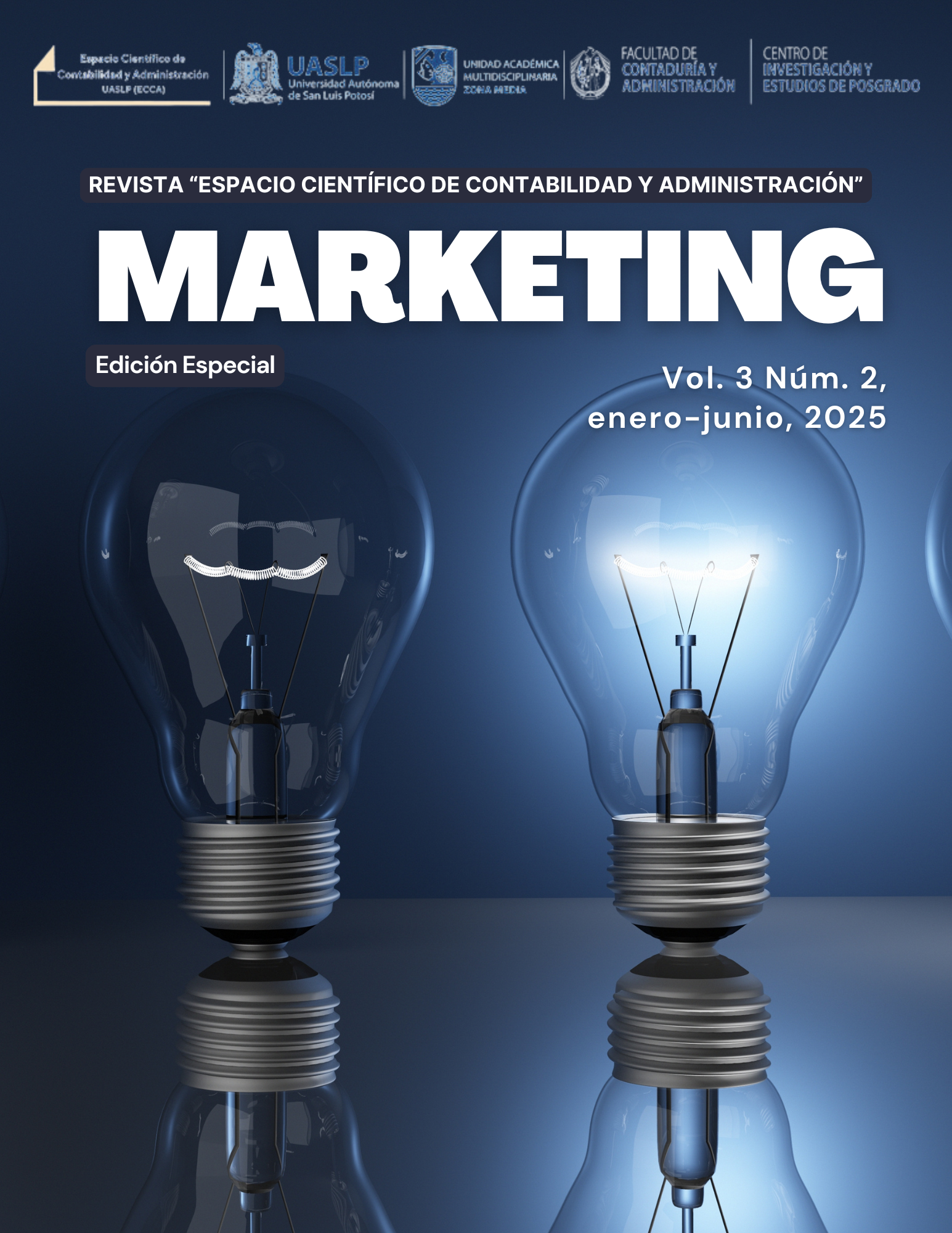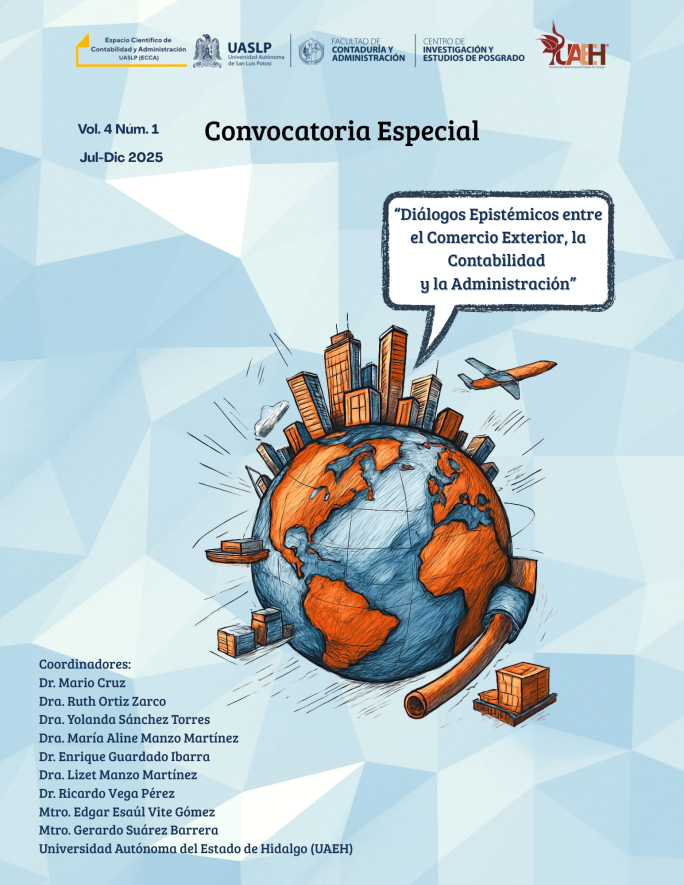The design of an instrument to analyze the acceptance of the use of AI in marketing
DOI:
https://doi.org/10.58493/ecca.2025.3.2.06Keywords:
artificial intelligence, marketing, aceptación tecnologica, UTAUT2Abstract
This study focuses on the transformation of marketing through artificial intelligence, highlighting its adoption influenced by factors such as trust, usefulness, and ease of use. The objective of this research is to design and validate an instrument based on the UTAUT2 model to assess the acceptance of AI in marketing. A quantitative methodology with a descriptive and causal design was used, with cross-sectional data collection. The instrument was validated through content validity, with peer review by marketing experts. The findings allowed for optimizing the number of items and ensuring the theoretical coherence of the dimensions evaluated. This study provides original value by facilitating the identification of barriers and drivers in the adoption of AI in commercial strategies.
References
Acosta-Enriquez, B. G., Arbulu Ballesteros, M., Vilcapoma Pérez, C. R., Huamaní Jordan, O., Martin Vergara, J. A., Martel Acosta, R., Arbulu Perez Vargas, C. G., & Arbulú Castillo, J. C. (2025). AI in academia: How do social influence, self-efficacy, and integrity influence researchers’ use of AI models? Social Sciences & Humanities Open, 11(101274), 101274. https://doi.org/10.1016/j.ssaho.2025.101274
Ali, M. S. M., Wasel, K. Z. A., & Abdelhamid, A. M. M. (2024). Generative AI and media content creation: Investigating the factors shaping user acceptance in the Arab gulf states. Journalism and Media, 5(4), 1624–1645. https://doi.org/10.3390/journalmedia5040101
Beh, P. K., Ganesan, Y., Iranmanesh, M., & Foroughi, B. (2021). Using smartwatches for fitness and health monitoring: the UTAUT2 combined with threat appraisal as moderators. Behaviour & Information Technology, 40(3), 282–299. https://doi.org/10.1080/0144929x.2019.1685597
Brown, & Venkatesh. (2005). Model of adoption of technology in households: A baseline model test and extension incorporating household life cycle. MIS quarterly: management information systems, 29(3), 399. https://doi.org/10.2307/25148690
Compeau, D. R., & Higgins, C. A. (1995). Application of Social Cognitive Theory to training for computer skills. Information Systems Research: ISR, 6(2), 118–143. https://doi.org/10.1287/isre.6.2.118
Cortez, P. M., Ong, A. K. S., Diaz, J. F. T., German, J. D., & Singh Jagdeep, S. J. S. (2024). Analyzing Preceding factors affecting behavioral intention on communicational artificial intelligence as an educational tool. Heliyon, 10(3). https://doi.org/10.1016/j.heliyon.2024.e25896
Davis, F. D. (1989). Perceived usefulness, perceived ease of use, and user acceptance of information technology. MIS quarterly: management information systems, 13(3), 319. https://doi.org/10.2307/249008
Davis, F. D., Bagozzi, R. P., & Warshaw, P. R. (1992). Extrinsic and intrinsic motivation to use computers in the workplace. Journal of Applied Social Psychology, 22(14), 1111–1132. https://doi.org/10.1111/j.1559-1816.1992.tb00945.x
Duong, C. D., Bui, D. T., Pham, H. T., Vu, A. T., & Nguyen, V. H. (2024). How effort expectancy and performance expectancy interact to trigger higher education students’ uses of ChatGPT for learning. Interactive Technology and Smart Education, 21(3), 356–380. https://doi.org/10.1108/itse-05-2023-0096
Gansser, O. A., & Reich, C. S. (2021a). A new acceptance model for artificial intelligence with extensions to UTAUT2: An empirical study in three segments of application. Technology in Society, 65(101535), 101535. https://doi.org/10.1016/j.techsoc.2021.101535
Gansser, O. A., & Reich, C. S. (2021b). A new acceptance model for artificial intelligence with extensions to UTAUT2: An empirical study in three segments of application. Technology in Society, 65(101535), 101535. https://doi.org/10.1016/j.techsoc.2021.101535
Gefen, & Straub. (2003). Managing User Trust in B2C e-Services. e-Service journal, 2(2), 7. https://doi.org/10.2979/esj.2003.2.2.7
Habibi, A., Mukminin, A., Octavia, A., Wahyuni, S., Danibao, B. K., & Wibowo, Y. G. (2024). ChatGPT acceptance and use through UTAUT and TPB: A big survey in five Indonesian Universities. Social Sciences & Humanities Open, 10(101136). https://doi.org/10.1016/j.ssaho.2024.101136
Hernández Sampieri, R., Collado, C. F., Lucio, P. B., Valencia, S. M., & Torres, C. P. M. (2014). Metodología de la investigación.
Hooda, A., Gupta, P., Jeyaraj, A., Giannakis, M., & Dwivedi, Y. K. (2022). The effects of trust on behavioral intention and use behavior within e-government contexts. International Journal of Information Management, 67(102553). https://doi.org/10.1016/j.ijinfomgt.2022.102553
Huang, Y.-T., Lin, C.-Y., & Wang, T.-H. (2024). Benefits of Give Circle: Exploring the impact of collaborative redistribution platforms on user willingness to donate to charity and tendency towards consumer minimalism. Computers in Human Behavior Reports, 14(100421), 100421. https://doi.org/10.1016/j.chbr.2024.100421
Khechine, H., Lakhal, S., & Ndjambou, P. (2016). A meta‐analysis of the UTAUT model: Eleven years later: A meta-analysis of the UTAUT model: Eleven years later. Canadian Journal of Administrative Sciences / Revue Canadienne des Sciences de l Administration, 33(2), 138–152. https://doi.org/10.1002/cjas.1381
Kotler, P., Setiawan, I., & Setiawan, H. (2022). Marketing 5.0 Versión Colombia: Tecnología para la humanidad. Lid Editorial.
Limayem, Hirt, & Cheung. (2007). How habit limits the predictive power of intention: The case of information systems continuance. MIS quarterly: management information systems, 31(4), 705. https://doi.org/10.2307/25148817
Oltra, I., Camarero, C., & San José, R. (2025). Agility in marketing teams: An analysis of factors influencing the entry decision into a trendy social network. Journal of Business Research, 187(115054). https://doi.org/10.1016/j.jbusres.2024.115054
Ridzky, D., & Sarno, R. (2020). UTAUT2 model for analyzing factors influencing user in using Online Travel Agent. 2020 International Seminar on Application for Technology of Information and Communication (iSemantic), 487–492.
Ruiz Santoyo, G. A., Aguilera Fernández, A., Juárez López, B., & Amarillas Urbina, V. A. (2021). Técnicas de análisis cuantitativo para economía y mercadotecnia. Ediciones de Laurel.
Singh, M., Yokohama National University, Matsui, Y., & Yokohama National University. (2017). How long tail and trust affect online shopping behavior: An extension to UTAUT2 framework. Editorial Introduction, 1–24. https://doi.org/10.17705/1pais.09401
Strzelecki, A., Cicha, K., Rizun, M., & Rutecka, P. (2024). Acceptance and use of ChatGPT in the academic community. Education and Information Technologies, 29(17), 22943–22968. https://doi.org/10.1007/s10639-024-12765-1
Taylor, S., & Todd, P. A. (1995). Understanding information technology usage: A test of competing models. Information Systems Research: ISR, 6(2), 144–176. https://doi.org/10.1287/isre.6.2.144
Thompson, R. L., Higgins, C. A., & Howell, J. M. (1991). Personal computing: Toward a conceptual model of utilization. MIS quarterly: management information systems, 15(1), 125. https://doi.org/10.2307/249443
Tseng, T. H., Lin, S., Wang, Y.-S., & Liu, H.-X. (2022). Investigating teachers’ adoption of MOOCs: the perspective of UTAUT2. Interactive Learning Environments, 30(4), 635–650. https://doi.org/10.1080/10494820.2019.1674888
Two Competing Perspectives on Automatic Use: A Theoretical and Empirical Comparison. (s/f). Information Systems Research.
van der Heijden. (2004). User Acceptance of Hedonic Information Systems. MIS quarterly: management information systems, 28(4), 695. https://doi.org/10.2307/25148660
Venkatesh, Morris, Davis, & Davis. (2003). User acceptance of information technology: Toward a unified view. MIS quarterly: management information systems, 27(3), 425. https://doi.org/10.2307/30036540
Venkatesh, Thong, & Xu. (2012a). Consumer acceptance and use of information technology: Extending the unified theory of acceptance and use of technology. MIS quarterly: management information systems, 36(1), 157. https://doi.org/10.2307/41410412
Venkatesh, Thong, & Xu. (2012b). Consumer acceptance and use of information technology: Extending the unified theory of acceptance and use of technology. MIS quarterly: management information systems, 36(1), 157. https://doi.org/10.2307/41410412

Downloads
Published
Issue
Section
License
Copyright (c) 2025 Luis Fernando Trejo Saucedo, Berenice Juarez Lopez, María Guadalupe Barrera García

This work is licensed under a Creative Commons Attribution-NonCommercial-ShareAlike 4.0 International License.
Usted es libre de:
- Compartir — copiar y redistribuir el material en cualquier medio o formato
- Adaptar — remezclar, transformar y construir a partir del material
- La licenciante no puede revocar estas libertades en tanto usted siga los términos de la licencia
Bajo los siguientes términos:
- Atribución — Usted debe dar crédito de manera adecuada , brindar un enlace a la licencia, e indicar si se han realizado cambios . Puede hacerlo en cualquier forma razonable, pero no de forma tal que sugiera que usted o su uso tienen el apoyo de la licenciante.
- NoComercial — Usted no puede hacer uso del material con propósitos comerciales .
- CompartirIgual — Si remezcla, transforma o crea a partir del material, debe distribuir su contribución bajo la la misma licencia del original.
- No hay restricciones adicionales — No puede aplicar términos legales ni medidas tecnológicas que restrinjan legalmente a otras a hacer cualquier uso permitido por la licencia.












